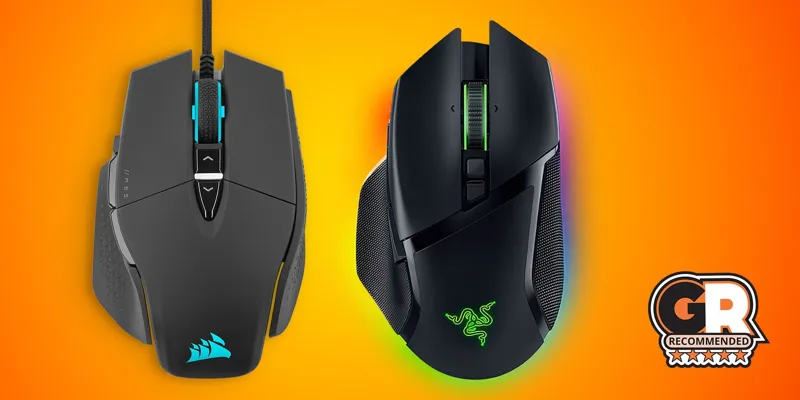When it comes to choosing the ultimate gaming mouse, Razer and Corsair emerge as frontrunners. Each company has charted distinct paths to becoming premier makers of gaming peripherals. Razer has set its sights on the gaming realm from the onset, offering stylish, high-performance gear. Conversely, Corsair initially gained recognition for other PC components before venturing into innovative gaming mouse technology, despite maintaining a wider product range than Razer.
Exploring the Differences in Razer and Corsair Mice
Razer and Corsair gaming mice share similar traits, making comparisons challenging. However, each mouse collection boasts unique advantages and drawbacks in several areas:
- Size/Shape: Both manufacturers produce compact, swift gaming mice suitable for intense FPS action, as well as larger, heavier alternatives with more buttons to cater to MMORPG gamers. The choice between the two largely depends on hand size and preferred gaming genre.
- Wired vs. Wireless: Razer and Corsair adopt different strategies to ensure accurate tracking and extended battery life for their wireless mice. They also feature distinct technologies even within their wired mouse range.
- Performance: With continuous enhancements in specs like DPI, acceleration, and polling rate, Razer and Corsair engage in an ongoing battle for mouse supremacy, with slight performance advantages in specific areas.
- Ergonomics: The comfort and grip offered by Razer and Corsair mice play a crucial role in extended gaming sessions.
- Style/RGB Effects: Gaming mice, albeit small, contribute to the overall aesthetics of gaming setups. Razer and Corsair mice offer varying RGB lighting capabilities that buyers should consider.
Size/Shape
Gaming mice exhibit significant variations in size, shape, and weight, aiming to accommodate personal preferences while impacting gaming performance. Razer and Corsair both manufacture smaller, lightweight gaming mice that effortlessly glide across mousepads. The 61-gram Razer Viper Mini caters to small hands, providing competitive gamers with swift target acquisition. On the other hand, Corsair's Katar Elite Wireless, with its compact and lightweight design, dominates FPS titles.
Larger gaming mice, although requiring more effort to maneuver, offer distinct advantages. For instance, the Razer Naga V2 Pro features an expansive shell with multiple buttons on its left panel, allowing for adaptability to various genres. Corsair produces several heavier mice, including the Corsair Scimitar Elite, providing adjustable buttons for varied grips.
Razer tends to focus on smaller, lightweight options, while Corsair leans towards larger, heavier mice, catering to different gamer preferences.
Wired vs. Wireless
Razer and Corsair have made significant strides in wireless gaming mice, addressing concerns about signal interference and battery life, while still offering wired alternatives. Both brands incorporate low-latency wireless protocols to match the performance of their wired counterparts. Razer's HyperSpeed RF and Corsair's Slipstream technologies ensure seamless wireless tracking.
Razer's HyperPolling wireless technology, exemplified in the Razer Viper V2 Pro, sets new standards with an 8,000 Hz polling rate, providing a slight edge in wireless mouse tracking. Corsair, while offering high polling rates in wired mice like the Sabre RGB Pro, emphasizes maneuverability with a lightweight paracord-type cable.
Performance
DPI, a commonly touted spec by manufacturers, dictates the movement detection capability of gaming mice. Razer and Logitech lead the pack with sensors exceeding 30,000 DPI. Razer's Focus Pro 30K optical sensor, present in mice like the Viper V3 HyperSpeed, ensures smooth tracking on any surface. Corsair's latest mice top out at 26,000 DPI, excelling in durability and responsive switches.
Corsair also incorporates Axon Hyper-Processing technology in select wired mice and keyboards, exemplified in the Sabre RGB Pro, providing a polling rate of 8,000 Hz for rapid and precise commands.
Ergonomics
Comfort and performance are paramount in gaming mice. Razer's Basilisk V3 Pro and Corsair's Dark Core RGB Pro SE stand out for their ergonomic designs, catering to medium to large-sized hands. Both offer thumb rests and button placements for prolonged gaming sessions. Additionally, Corsair's Dark Core Pro SE features swappable grips, enhancing user customization.
Style & RGB Lighting
RGB lighting has become integral to gaming aesthetics. Razer and Corsair offer customizable lighting effects, with Razer's Synapse and Corsair's iCue software allowing synchronization with other components. Razer's Basilisk V3 Pro and Corsair's Dark Core RGB Pro SE showcase varying lighting capabilities, contributing to the overall gaming setup aesthetics.
The Razer vs. Corsair Gaming Mice Verdict
Both Razer and Corsair cater to diverse gaming preferences, offering mice tailored to specific gaming genres, hand sizes, and aesthetic preferences. The decision between the two ultimately depends on individual needs and gaming inclinations.
FAQ
Q: Do professionals use Razer?
Many competitive gamers favor Razer's lightweight and agile mice, especially for FPS titles, owing to their speed and reliable tracking.
Q: Are Corsair mice suitable for FPS games?
Corsair, known for its bulky and button-rich mice, also produces compact and lightweight models like the M75 Air, ideal for FPS gaming.
Q: What does DPI mean?
DPI, or "dots per inch," denotes the mouse's movement detection rate, influencing cursor movement on screen.

